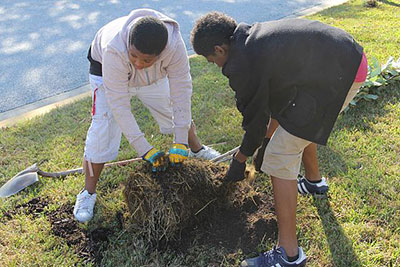By Deanne Buckman, Policy Intern
This is part 2 of a two-part series. Catch up here!
Criminological theories help us to understand why urban forests may be able to reduce crime rates.
By attracting people to public outdoor areas, urban green spaces create more opportunities for community members to interact with one another, which leads to the development of neighborly bonds and social capital. This creates the appearance that the spaces are defended by residents and, in turn, has the effect of deterring criminals from targeting the area. Urban forests can also reduce crime by restoring mental health and reducing the strain that can be caused by life in cities.

What is less clear is how to plan for urban forests that produce the most positive community impact. The underprivileged communities that stand to gain the most from these green spaces typically have the smallest amount of them compared to the wealthier, more suburban areas in which they are more abundant. For example, American Forests’ Community ReLeaf assessment of Atlanta’s urban forest found that the total average combined income for the 10 zones in the city with the most tree canopy is almost twice the total average combined income of the 10 zones with the least amount of tree canopy.
Unfortunately, the problem can be more complicated than just unequal distribution of resources. Installing vegetation and green space in these communities can create what is being called an “urban green space paradox” (Wolch et al, 2014). As more green space is implemented, the attractiveness and public health of the neighborhood may improve, making it more desirable and increasing property value — the very residents who were supposed to benefit from the urban greening may be forced to relocate.
And, because parks in wealthy or middle-class neighborhoods receive care because of abundant resources, they are more likely to create a sense of stewardship and, thereby, reduce crime. Poorly maintained green spaces in underserved communities may actually increase crime (Wolfe and Mennis, 2012). Simply put, urban forests are a long-term investment requiring much more care than natural forests and will only reduce crime if they are continuously maintained.
The support for urban forestry as a method of crime reduction is positive. Yet, there is still much more research to be done to discover the best possible way to implement and maintain green spaces so that they accomplish what they are meant to. The right trees must be chosen so that they are not view obstructing; trees must be implemented in a way that creates a sense of ownership within the community; and there must be dedication and funding from governments and other community stakeholders to maintain the forests over the long term.
With these things in mind, urban forests show real promise for making a difference in some of our most vulnerable communities.
Sources Cited:
- Wolch, Jennifer, et al. Urban Green Space, Public Health, and Environmental Justice: The Challenge of Making Cities “Just Green Enough”. Landscape and Urban Planning. Vol 125. May 2014. P. 234-244.
- Wolfe, Mary K., and Jeremy Mennis. “Does Vegetation Encourage or Suppress Urban Crime? Evidence from Philadelphia, PA.” Landscape and Urban Planning. Vol. 108.2-4. 2012. P. 112-22.